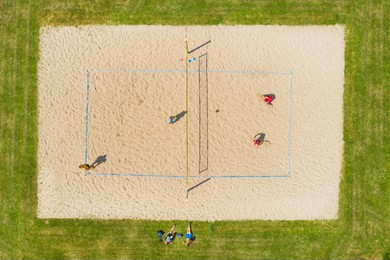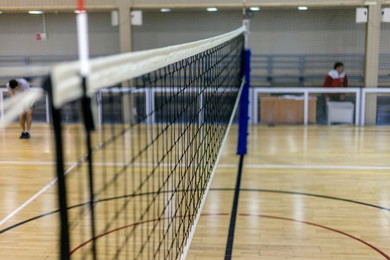Looking for a new way to enjoy the summer sun with friends and family? Grab a ball and head to the beach for a game of volleyball! But before you spike that ball, make sure you’re playing on the right court. Knowing the proper beach volleyball court dimensions is key to a fair, competitive game and can make all the difference in your game strategy.
The recommended size for a beach volleyball court, as stated by the Association of Volleyball Professionals (AVP), is 16 meters in length and 8 meters in width, which is equivalent to 52 feet 6 inches long and 26 feet 3 inches wide.
Today I’ll cover the dimensions of the beach volleyball courts, distinctions between the beach and indoor volleyball, and focus on differences in court size and gameplay rules.
Dimensions of a Beach Volleyball Court

The dimensions of a standard beach volleyball court are 16 meters (52.5 feet) in length and 8 meters (26.25 feet) in width. The court is divided into two equal halves by a center line.
The entire court is surrounded by a boundary line, which marks the outer limits of the playing area. The boundary line is 5 cm wide and is considered to be “in” or “on” if the ball touches any part of it during play.
At the center of the court, there is a small circular area, which marks the center of the court. This circle has a radius of 0.5 meters (1.64 feet) and is used for service.
The service area is located behind the back boundary line and is divided into two parts – the serving team’s court and the receiving team’s court. The serving team’s court is the side of the court from which the serve is made.
There are two attack lines on the beach volleyball court. They are located 3 meters (9.84 feet) back from the center line on either side of the court and run parallel to the center line. These lines mark the boundaries beyond which the attacking team cannot cross when making an attack hit or spike.
Difference between Beach Volleyball and Indoor Volleyball

Beach volleyball and indoor volleyball are two versions of the same sport, but they vary in several aspects, with one of the most evident distinctions being the size of the court.
| Points of Difference | Indoor Volleyball | Beach Volleyball |
| Team Size | There are six active players on a team. In a set, players can be substituted up to six times. A bench player’s number is not determined. | A team consists of 2 players. There are no substitutions. |
| Player Positions | When the receiving team scores a point, the serving and receiving teams rotate positions. It is only after losing possession of the ball that the serving team rotates. | The ball is switched only after the server gains possession. |
| Attack Line | A 9 feet 10 inch (3-meter) attack line separates frontcourt players from backcourt players. | Beach volleyball courts do not have an attack line. |
| Winner | When a team scores 25 points in a set, it wins. Three sets must be won by the winning team. | To win a set, you must score 21 points first. Two sets must be won by the winning team. |
| Score System | Points can only be scored by the serving team. Receiving teams do not receive points if the serving team loses possession of the ball. | There is no difference between who serves the ball and who scores a point. |
| Weather Conditions | Weather does not affect games. | It is only possible to play games when the weather is ideal. A postponement is made if it rains. |
| Ball Size and Weight | There must be a ball with a circumference of 25.5 to 26.5 inches and a weight between 9 and 10 ounces. | There must be a ball with a circumference of 25.9-26.8 inches and a weight of 9-10 ounces. |
| Ball Material | A smooth surface is created by gluing together real or synthetic leather panels. | A soft surface is created by stitching together pieces of leather or synthetic leather. |
| Tipping | The ball can be tipped over the net by players. | Hands and straight/curled fingers are the only ways for players to strike the ball. |
| Blocking | As long as the team hits the ball three more times, a block does not count as a touch. | The team can only hit the ball two more times after a block counts as a touch. |
| Uniforms | Shirts and pants are typically made of spandex. | There are many different types of clothing players wear, such as beach shorts, tank tops, and bikinis. Unless otherwise specified by the organizing committee, footwear is not required. |
Variations on Beach Volleyball Court Dimensions

Beach volleyball court dimensions can vary based on the level of play, with smaller courts typically used for youth or recreational play, and larger courts for professional tournaments. The standard dimensions for a professional beach volleyball court are 16 meters (52 feet, 6 inches) long by 8 meters (26 feet, 3 inches) wide.
However, smaller courts are often used for recreational play or in youth leagues, with dimensions ranging from 12 meters (39 feet, 4 inches) to 14 meters (45 feet, 11 inches) in length and 6 meters (19 feet, 8 inches) to 7 meters (22 feet, 11 inches) in width. These smaller courts can be more suitable for beginners or younger players, as they require less stamina and physical ability to cover the court.
Regional or organizational variations on beach volleyball court dimensions
In addition to the variation in court size based on the level of play, there can also be regional or organizational differences in court dimensions.
For example, the International Volleyball Federation (FIVB) regulation beach volleyball court size is 16 meters by 8 meters, while the United States Volleyball Association (USAV) permits slightly smaller courts of 52 feet by 26 feet for their sanctioned events.
Some organizations also permit courts that are slightly larger, up to 18 meters (59 feet) in length, for certain events or competitions.
Comparison to indoor volleyball court dimensions
Compared to indoor volleyball court dimensions, beach volleyball courts are generally smaller. The standard indoor volleyball court measures 18 meters (59 feet) in length and 9 meters (29.5 feet) in width.
Indoor volleyball courts have additional space requirements for the playing area, including clearance for players to jump and land safely. This makes indoor volleyball a more physically demanding sport than beach volleyball, as players cover a larger playing area and must be able to jump higher and move faster in order to compete effectively.
Setting Up a Beach Volleyball Court
Setting up a beach volleyball court can seem like a daunting task, especially if you’re unfamiliar with the rules of the game or are inexperienced with measuring and marking a court. However, with some basic guidelines and materials, anyone can set up a court that players of all skill levels can enjoy. Here’s what you need to know:
Measuring and Marking a Court
The standard beach volleyball court measures 8 meters (26.25 feet) wide and 16 meters (52.5 feet) long. To mark the court, you’ll need a measuring tape, a tape measure, and some form of marker (such as spray paint or chalk). Here’s how to do it:
- Measure out the length of the court (16 meters) and mark both ends with a perpendicular line.
- Measure out the width of the court (8 meters) and mark both sides with a perpendicular line.
- Connect the four corners of the court with straight lines.
- Divide the court in half lengthwise to create two equal halves (each 8 meters by 8 meters).
- Along the lengthwise centerline, draw a short line every meter (3.3 feet) to designate the “attack line” for each team.
Materials for Creating a Beach Volleyball Court
The materials you need for creating a beach volleyball court will depend on whether you’re setting up a temporary or permanent court, as well as the surface you’re working with (more on that below). Here are some basic materials you’ll need:
- A net and poles (most beach volleyball nets are 2.43 meters or 8 feet high)
- Anchor systems for the net (such as sandbags or stakes)
- Boundary markers (such as cones or boundary lines)
- A level for ensuring the court is even
- Materials for marking the court (such as spray paint or chalk)
- Tools for digging holes (if you’re setting up a permanent court)
Setting Up a Court in Different Environments
The type of surface you’re working with will affect how you set up your beach volleyball court. Here are some considerations for different environments:
- Sand: To set up a beach volleyball court on the sand, you’ll need to ensure the sand is firm enough to play on (i.e. not too loose). You may need to level the sand and dampen it with water to make it easier to play on. You can use sandbags or stakes to anchor the net, and boundary lines made of tape or string can be used to designate the court boundaries.
- Grass: Setting up a beach volleyball court on grass is similar to setting one on the sand, but you don’t need to worry about leveling the surface. However, you will need to mow the grass short and make sure it’s even. Anchoring the net can be trickier on grass, so you may need to use longer stakes or heavier sandbags. You can also use boundary lines made of tape or string.
- Pavement: If you’re setting up a beach volleyball court on the pavement (like a parking lot or basketball court), you’ll need to be careful not to damage the surface. You can use sandbags or weights to anchor the net, and tape or paint can be used to mark the court boundary. You may consider using a portable net system that doesn’t require anchoring.
Related: What Are The Dimensions of Volleyball Net?
FAQs
What are the dimensions of a beach volleyball court?
The dimensions of a standard beach volleyball court are 52.5 feet (16 meters) long and 26.25 feet (8 meters) wide.
What are the dimensions of a 2v2 beach volleyball court?
The dimensions of a 2v2 beach volleyball court are the same as a standard beach volleyball court, which is 52.5 feet (16 meters) long and 26.25 feet (8 meters) wide.
What are 6 What are the dimensions of a volleyball court?
The dimensions of a volleyball court are 59 feet (18 meters) long and 29.5 feet (9 meters) wide.
What is the volleyball court dimension?
The volleyball court dimension is 59 feet (18 meters) long and 29.5 feet (9 meters) wide.